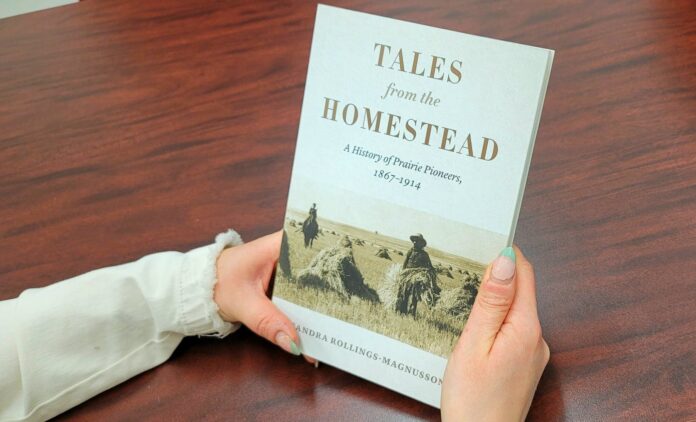A new tome has 36 different narratives written from the homesteader’s perspective during the homesteading era from 1867 to 1914. It includes references from people who settled in the Lloydminster area.
“Tales from the Homestead” is the fourth homesteader publication from MacEwan University Professor Sandra Rollings-Magnusson who says it gives a full description of life during that period.
“It includes all sorts of ethnic backgrounds. Everything from Doukhobor to Mennonites, Ukrainians, English, Scottish, Welsh, Danish, Polish and German.”
The Lloydminster references detail firsthand accounts of travelling by scow along the North Saskatchewan River from Edmonton to Lloydminster in the early 1900’s. As well the fight to save the town from a prairie fire in 1905 and as well the festive, adventurous bachelor life of coming to a town that’s split between two provinces.
Rollings-Magnusson continues,”They are basically short stories about different aspects of the homesteading era. Everything from travelling to Canada by ship; by train to the western prairies. By Red River cart to their homestead. It talks about their trials and tribulations in terms of the weather and geography. It also highlights the good times in terms of coming together as a family and working together as a family for their survival. Visiting with neighbours. Going to dances.”
“Tales from the Homestead” gets into the social interactions among the diversity of groups making their way to western Canada. Rollings-Magnusson describes it as a difficult process for the 100’s of thousands of people speaking different languages. They had to adapt to the climate and break up the land and farm wheat for the export market as well as make use of the native flora and fauna be it berries and wild game for their survival.
Rollings-Magnusson says some of the take-aways are their perseverance and ability to find happiness in the little things despite the hardships.
“Many of them would have lost their homestead because if they did not meet homesteader requirements within three years, they would lose it. So they had to be very hardworking individuals to succeed. Another aspect we can learn from them is to take joy in even the smallest things in life. When they had the opportunity to have a dance on the weekend, people from 25 miles around would gather in excitement. All ages from the smallest of babies. Everyone would come for the dance, to meet up with their neighbours.”
The professor says even the odd visitor would enjoy prairie hospitality with some tea, coffee, a biscuit or whatever they had. She said they had to adapt to their new society.
“I think the homesteaders had to be of the same mind. They had to be open to others. Any biases or prejudices they had in the past; they had to be put aside because there were just so many different people that came out to the western prairies at one time. All different cultures. All different countries and they had to learn how to get along with each other.”
In that respect Rollings-Magnusson sees another contemporary resonance as the importance of socialization to overcome the isolation of life on the prairies.
“People went onto their homestead and they were isolated from others. That’s why they receive such joy when somebody came by to visit because they were so far away from neighbours. And with COVID of course people are isolated and they were lacking that social contact. That kind of links contemporary times back to historical times.”
Rollings-Magnusson is working on two more books dealing with homesteading and she also collects antiques from that era. She has homesteading ancestors on both sides of her family.
“Tales from the Homestead” is available at Audrey’s in Edmonton, McNally’s in Saskatoon and as well from Indigo and Amazon.




